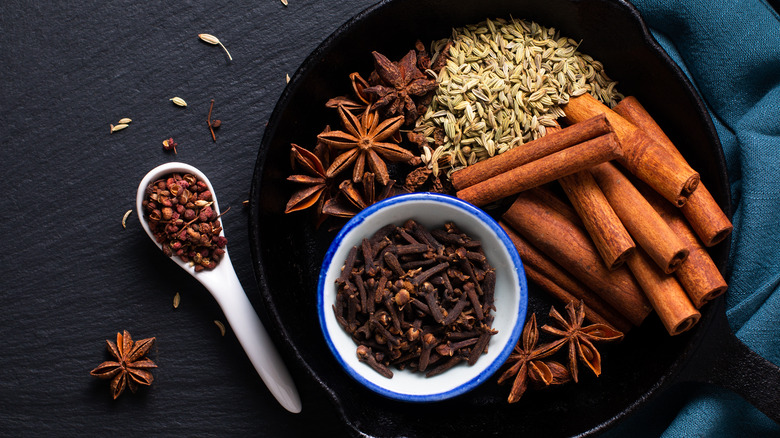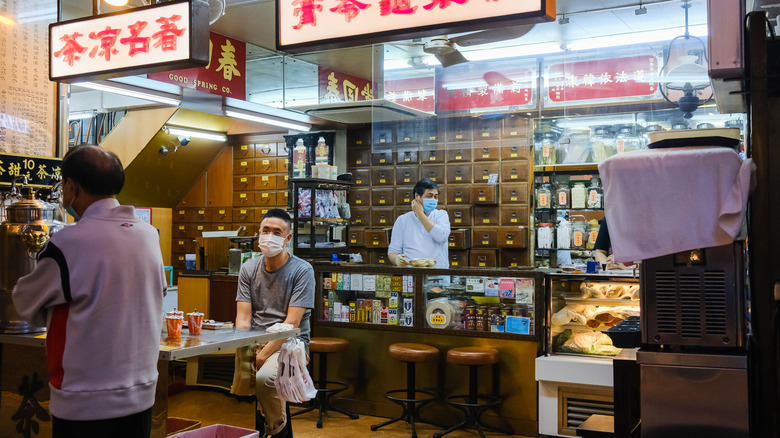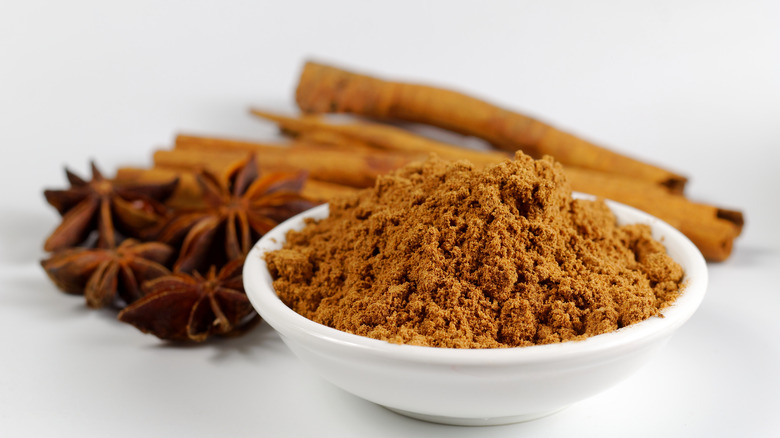The Surprising Link Between Chinese Five-Spice Powder And Herbal Medicine
It's the spice mix that adds flavor to signature classic Chinese dishes including Peking Duck, per Food., as well as the more contemporary Taiwanese Salt and Pepper Chicken, per Takes Two Eggs. It is also the flavor cornerstone on which many braised Chinese meat dishes are built for a dish also known as "luwei", per Taiwan Panorama. No surprises then that because it is used in many recipes, Serious Eats describes Chinese five-spice powder as the add-in that "elevates fatty, meaty dishes to mysterious heights."
MasterClass compares Chinese five-spice to Indian garam masala, which are whole spices that are toasted before they are ground into a powder. Today, Serious Eats says a Chinese five-spice blend will usually contain a mix of anise, fennel, cinnamon, clove, and Sichuan peppercorns. Although, other herbs and spices like black pepper, ginger root, clove, dried orange peel, and licorice might make it into the flavorful blend from time to time.
Ancient Chinese believed in mixing flavors to create new ones
The idea that Chinese five-spice represents five distinct flavors that belong together may have its roots in Chinese food history. Scholar Hong Guang-zhu said Chinese society had long believed that food flavors are grouped into "salty, sour, bitter, pungent, and sweet" and that putting these five different base flavors together in different ratios would yield new taste profiles, per Taiwan Panorama.
Chinese five-spice didn't always come powdered; the spices were once cooked whole. To keep them together, they were packed in little muslin bags which were then tossed into the dish, in much the same way whole herbs are tied or bundled together and used in French Provencal cooking, per Michelin.
But, while the herbs that make up a bouquet garni could be found in many gardens, there was only one place cooks could get their five-spice, and that was at the Chinese medicine store. Taiwan Panorama quotes Theresa Lin as saying: "I remember 15 years or so ago that to buy five-spice we always went to a Chinese herbal medicine shop, where the shopkeeper would make up the mixture on the spot from the individual spices, just like filling a herbal prescription." It took a while before powdered five-spice blends were available commercially, reducing the need for cooking with whole spices.
An old recipe from the Song Dynasty lists ingredients included in five-spice
The five-spice powder is a "perfectly calibrated balance" of flavors, as MasterClass writes, and Taiwan Panorama suggests it came about after centuries of blending different flavors — a task which began with the discovery and use of tangerines in cooking, to the introduction of star anise from Southeast Asia. While no one knows exactly when or how the spice mix was born, it wouldn't be surprising if Chinese five-spice turns out to be several hundred years old. Case in point: a Song Dynasty (A.D. 930 to 1276) cookbook lists out the spice ingredients for wet fermented soybeans as "star anise, fennel, caoguo, cinnamon, costus root (Saussurea lappa), chenpi, Sichuan peppercorns, dried shredded ginger, and almonds".
Taiwan Panorama also adds that because the Chinese people like to draw connections between ingredients and herbal medicine, it would not be surprising for the blend to have had a medicinal function at one point. But, as one food scientist from National Taiwan University put it, other than improving the flavor of food, the elements found in five-spice are present "in such small quantities, they don't provide the body with any nutritional value to speak of."


